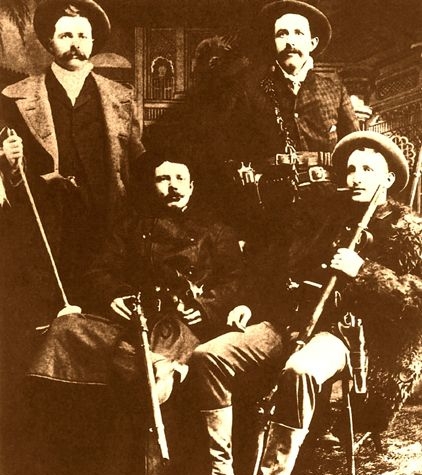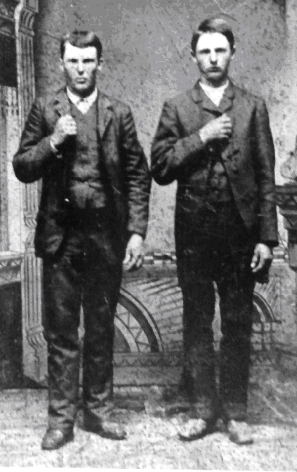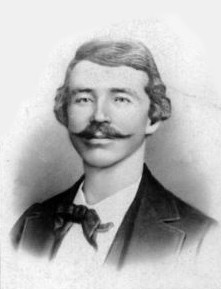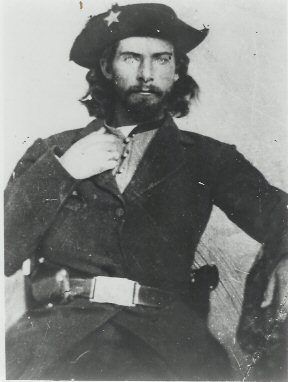|
The James-Younger Gang History
The
James-Younger Gang was a legendary 19th century band of American outlaws.
| James-Younger Gang |

|
| James-Younger Gang |
(Right) James-Younger Gang. The James-Younger Gang - Left to right: Cole
Younger, Jesse Woodson James, Bob Younger, and Frank James.
The gang was centered in the state
of Missouri.
Its membership fluctuated from robbery to robbery, as the outlaws' raids were usually separated by many months. At times,
it included the Younger Brothers (Cole, Jim, John, and Bob), the James Brothers, aka Frank and Jesse James Gang (Frank and his brother Jesse), Clell Miller, Arthur McCoy, Charlie
Pitts, John Jarrette (who was married to Cole's sister Josie), and Bill Chadwell. Contrary to frequent report, the James brothers
and Younger brothers were not related, at least not by blood. Starting in 1879, after the demise of the James-Younger Gang,
The James brothers committed further crimes with Clell Miller's brother Ed, the Ford brothers (Robert and Charles), Bill Ryan,
Dick Liddil, and the Hite Brothers Wood and Clarence.
The James-Younger Gang had
its origins in a group of Confederate bushwhackers who fought in the bitter partisan conflict that wracked the divided state
of Missouri during the American Civil War. This group's
postwar crimes began in 1866, though it did not truly become the "James-Younger Gang" until 1868 at the earliest, when the
authorities first named Cole Younger and both the James brothers as suspects in the robbery of the Nimrod Long bank in Russellville, Kentucky. It dissolved
in 1876, after the capture of the Younger brothers in Minnesota
with its ill-fated attempt to rob the Northfield First National Bank. Three years later, Jesse James organized a new gang
and renewed his criminal career, which came to an end with his death in 1882. During the gang's period of activity, it robbed
banks, trains, and stagecoaches in Missouri, Kentucky, Iowa, Texas, Arkansas, Kansas, and West Virginia.
Early in the American Civil War,
the state of Missouri fell into Union hands. Missouri, however, had been the center of much of the agitation leading
up to the outbreak of the war, and was home to dedicated partisans of both sides. Well before the end of 1861, local Unionists
and secessionists began to battle each other across the state, and guerrilla warfare erupted between Confederate insurgents
and organized Union forces. By early 1862, the Unionist provisional government mobilized a state militia to fight increasingly
organized and deadly guerrillas. This conflict (fought largely, though not exclusively, between Missourians
themselves) raged until after the fall of Richmond and the
surrender of General Robert E. Lee, costing thousands of lives and devastating broad swathes of the countryside.
The James and Younger brothers
belonged to slave-owning families with ties to the South. Zerelda Samuel, the mother of Frank and Jesse James, was an outspoken
partisan of the South, though the Youngers' father, Henry Washington Younger, was believed to be a Unionist. Cole Younger's
initial decision to fight as a "bushwhacker," or Confederate guerrilla, is usually attributed
to the death of his father at the hands of Union forces. He and Frank James had served and fought under one of the most famous
bushwhacker leaders, William Clarke Quantrill, though Cole eventually joined the regular Confederate army. Jesse James began
his guerrilla career in 1864, at the age of sixteen, fighting alongside Frank under the leadership of Archie Clement and "Bloody Bill" Anderson. See also Missouri Civil War History and Border State Civil War History.
At war's end, Frank James surrendered in Kentucky; Jesse
James surrendered after being shot through the lung outside of Lexington, Missouri; and Cole Younger returned from a mission to California.
Quantrill and Anderson had both been killed. The James brothers, however, continued to associate with their old guerrilla
comrades, who remained together under the leadership of Archie Clement. It was likely Clement who, amid the tumult of Reconstruction in Missouri,
turned the guerrillas into outlaws; an era which is commonly referred to as the Wild West.
On February 13, 1866, a
group of gunmen carried out the first daylight, peacetime, armed bank robbery in U.S. history, when they held up the Clay County Savings Association, stealing some
$60,000 in cash and bonds. The state authorities suspected Archie Clement of leading the raid, and promptly issued a reward
for his capture. In later years, the list of suspects would grow to include Frank James, Cole Younger, John Jarrette, Oliver
Shepard, Bud and Donny Pence, Frank Greg, Bill and James Wilkerson, Joab Perry, Ben Cooper, Red Mankus and Allen Parmer (who
later married Susan James, Frank and Jesse's sister). The outlaws also killed George Wymore, a bystander on the street outside
the bank.
That crime began a string
of robberies, many of which were linked to Clement's group of bushwhackers. The hold-up most clearly linked to the group was
of Alexander Mitchell and Company in Lexington, Missouri,
on October 30, 1866, which netted $2,011.50. Clement was also linked to violence and intimidation against officials of the
Republican government that now ruled the state. On election day, Clement led his men into Lexington,
where they drove Republican voters away from the polls, and secured a Republican defeat. A detachment of state militiamen
was dispatched to the town. They convinced the bushwhackers to disperse and then attempted to capture Clement, who still
had a price upon his head. Clement refused to surrender, and was shot down in wild gunfight on the streets of Lexington.
Despite the death of Clement,
his old followers remained together, and robbed a bank across the Missouri River from Lexington
in Richmond, Missouri, on
May 22, 1867, in which the Town Mayor and two lawmen were killed. This was followed on March 20, 1868, by a raid on the Nimrod
Long bank in Russellville, Kentucky.
In the aftermath of the two raids, however, the more senior bushwhackers were killed or captured. This set the stage for the
emergence of the James and Younger brothers, and the transformation of the old Clement crew into the James-Younger Gang.
On December 7, 1869, Frank and
Jesse James were believed to have robbed the Davies County Savings Association in Gallatin,
Missouri. Jesse was suspected of shooting down the cashier, John W. Sheets, in
the mistaken belief that he was Samuel P. Cox, the Union militia officer who had ambushed and killed "Bloody Bill" Anderson during the Civil War. The notoriety of the crime, a dramatic
escape through the midst of a posse a few days later by the James brothers, and letters to the press that followed, written
by Jesse, made Jesse James famous. He would only grow more famous, and notorious, until his death more than a decade later.
| James-Younger Gang |

|
| James-Younger Gang |
(Photo) Jesse and Frank James, 1872.
On June 3, 1871, Frank and
Jesse James, Cole Younger, and Clell Miller robbed the bank in Corydon, Iowa. The bank
contacted the Pinkerton National Detective Agency in Chicago,
the first involvement of the famous agency in the pursuit of the James-Younger Gang. Agency founder Allan Pinkerton dispatched
his son, Robert Pinkerton, who joined a county sheriff in tracking the gang to a farm in Civil Bend, Missouri. A short, indecisive
gunfight ensued, as the gang successfully escaped. On June 24, 1871, Jesse James wrote a letter to the Kansas City Times,
claiming Republicans were persecuting him for his Confederate loyalties by accusing him and Frank of carrying out the robberies.
"But I don't care what the degraded Radical party thinks about me," he wrote, "I would just as soon they would think I was
a robber as not."
On April 29, 1872, the gang
robbed a bank in Columbia, Kentucky.
One of the outlaws shot down the cashier, R.A.C. Martin, who refused to open the safe. On September 23, 1872, three men (identified
by former bushwhacker Jim Chiles as Jesse James and Cole and John Younger) robbed a ticket booth of the Second Annual Kansas
City Industrial Exposition, amid thousands of people. They took some $900, and accidentally shot a little girl in the ensuing
struggle with the ticket seller. The crime was praised by Kansas City Times editor John Newman Edwards in a famous editorial
entitled, "The Chivalry of Crime." He soon published an anonymous letter from one of the outlaws, believed to be Jesse James,
which referred to the approaching presidential election. "Just let a party of men commit a bold robbery, and the cry is hang
them. But [President Ulysses S.] Grant and his party can steal millions and it is all right," the outlaw wrote. "They rob
the poor and rich, and we rob the rich and give to the poor."
On May 27, 1873, the James-Younger
gang robbed the Ste. Genevieve Savings Association in Ste. Genevieve, Missouri.
As they rode off they fired in the air and shouted, "Hurrah for Hildebrand!" Samuel S. Hildebrand was a famous Confederate
bushwhacker from the area, who had recently been shot dead in Illinois.
On July 21, 1873, the gang
carried out its first train robbery, derailing a locomotive of the Rock Island Railroad near Adair, Iowa. Engineer John Rafferty died in the crash. The
outlaws took $2,337 from the express safe in the baggage car, having narrowly missed a transcontinental express shipment of
a large amount of cash.
On November 23, 1873, John
Newman Edwards published a lengthy glorification of the James brothers, Cole and John Younger, and Arthur McCoy, in a twenty-page
special supplement to the St. Louis Dispatch, his new newspaper. Most of the supplement, entitled "A Terrible Quintet," was
devoted to Jesse James, the gang's public face, and the article stressed the outlaws' Confederate loyalties.
In January 1874, the outlaws were
suspected of holding up a stagecoach in Bienville Parish, Louisiana, and later another between
Malvern and Hot Springs, Arkansas.
At the latter, the gang returned a watch to a Confederate veteran, saying, "Northern men had driven them to outlawry, and
they intended to make them pay for it." On January 31, 1874, the gang robbed a southbound train on the Iron Mountain Railroad
at Gads Hill, Missouri. For
the first of only two times in all their train robberies, the outlaws robbed the passengers; in both instances, their usual
target, the safe in the baggage car belonging to an express company, held an unusually small amount of money. On this occasion,
the outlaws reportedly examined the hands of the passengers, to ensure that they did not rob any working men.
| James-Younger Gang |

|
| James-Younger Gang |
(Right) William Clarke Quantrill. Although Quantrill was not a member of the James-Younger Gang, he was a major influence regarding the "Gang's" early
stages and formation. Many of its members had served in Quantrill's Raiders during the Civil War and had witnessed and engaged in fierce fighting from bushwhacking to major Civil War battles.
The Adams Express Company,
which owned the safe robbed at Gads Hill, hired the Pinkerton National Detective Agency to capture the outlaws. On March 11,
1874, John W. Whicher, the agent sent to investigate the James brothers, was found shot to death alongside a rural road in
Jackson County, Missouri. Two other agents, John Boyle and Louis J. Lull, accompanied by Deputy Sheriff Edwin B. Daniels,
posed as cattle buyers as they tracked the Youngers. On March 17, 1874, the trio was stopped by John and Jim Younger on a
rural stretch of road near Monegaw Springs, Missouri. Boyle escaped, Lull and Daniels
were shot, and John Younger was killed by Lull. Daniels died on the spot, but Lull lived long enough to testify before a coroner's
inquest before succumbing to his wounds a few days later.
The Pinkerton deaths added
to the growing embarrassment suffered by Missouri's first
postwar Democratic governor, Silas Woodson. He issued a $2,000 reward offer for the Iron Mountain robbers (the highest reward offered
for criminals was $300) and persuaded the state legislature to provide $10,000 for a secret service fund to track down the
famous outlaws. The first agent, J. W. Ragsdale, was hired on April 9, 1874. On August 30, 1874, three of the gang held up
a stagecoach across the Missouri River from Lexington, Missouri,
in view of hundreds of onlookers on the bluffs of the town. Two of the robbers were identified by a passenger as Frank and
Jesse James. The acting governor, Charles P. Johnson, dispatched an agent selected from the St. Louis police department. In early September, the agent caught up to Jesse James and Jim
Younger on a rural road in Ray County,
though they escaped after a sharp but indecisive gunfight on horseback.
The gang next robbed a train
on the Kansas Pacific Railroad near Muncie, Kansas,
on December 8, 1874. It was one of the outlaws' most successful robberies, gaining them $30,000. A new addition to the gang,
William "Bud" McDaniel, was captured by a Kansas City police
officer after the robbery, and later was shot during an escape attempt.
On the night of January
25, 1875, the Pinkertons surrounded the James farm. Frank and Jesse James had likely been there earlier, but had already left.
The Pinkertons threw an iron incendiary device into the house, which exploded when it rolled into a blazing fireplace. The
blast nearly severed the right arm of Zerelda Samuel, the James boys' mother (the arm had to be amputated at the elbow that
night), and killed their 9-year-old half brother, Archie Samuel. On April 12, 1875, an unknown gunman shot dead Daniel Askew,
a neighbor (and former Union militiaman) who had provided the Pinkertons with a base for their raid. Allan Pinkerton now abandoned
the chase after the James-Younger Gang.
| James-Younger Gang |

|
| James-Younger Gang |
(Left) "Bloody Bill" Anderson.
"Bloody Bill", a lieutenant that also served under the command of William Clarke Quantrill during the Civil War (Quantrill's
Raiders), was another mentor for the James-Younger Gang.
On May 13, 1875, the outlaws
robbed a rural store north of Clinton, Missouri, for $300. On September
1, 1875, the gang ventured to Huntington, West Virginia,
to rob the bank there. Tom McDaniels (brother of Bud) and Tom Webb joined the crew for the raid, but McDaniels was killed
by a posse and Webb was caught.
Also in 1875, the two James
brothers moved to the outskirts of Nashville, Tennessee;
probably to save their mother from further raids by detectives. Jesse James then began to write letters to the local
press, asserting his place as a Confederate hero and martyr to Radical Republican vindictiveness.
On July 7, 1876, Frank and
Jesse James, Cole, Jim, and Bob Younger, Charlie Pitts, Bill Chadwell, and Hobbs Kerry robbed the Missouri Pacific Railroad
at the "Rocky Cut" near Otterville, Missouri.
Kerry, a raw recruit, was arrested soon after and he readily identified his accomplices.
The Rocky Cut raid set the
stage for the final act in the history of the James-Younger Gang: the famous Northfield,
Minnesota Raid. The target was the
First National Bank of Northfield, located far outside of the gang's usual territory, which
previously had included only the South and the Border States. The bank, according to public reports that were required of all national banks, was a perfectly ordinary
rural bank. Shortly after the robbery, Bob Younger declared that they had selected it because of its connection to
two Union generals and Radical Republican politicians: Benjamin Butler and Adelbert Ames. Ames
had just stepped down as governor of Mississippi, where he had been strongly identified with
civil rights for freedmen, and had recently moved to Northfield,
where his family owned a mill and a large amount of stock in the bank. One of the outlaws "had a spite" against Ames, Bob said. Cole Younger made the identical remarks years later.
Frank and Jesse James, Cole,
Jim and Bob Younger, Charlie Pitts, Clell Miller, and Bill Chadwell took the train to St. Paul
and Minneapolis at the beginning of September 1876. They divided
into two groups, one going to Mankato, Minnesota, and the
other to Red Wing, on either side of Northfield. They purchased
horses and scouted the terrain around the town. On September 7, 1876, at 2 p.m., they attempted to rob the bank. Three outlaws
entered the bank, and the other five stood guard outside. The citizens realized a robbery was in progress and took-up arms.
Shooting from behind cover, they poured a deadly fire on the outlaws, killing Miller and Chadwell, and wounding the Youngers
(particularly Bob, who suffered a shattered elbow). They also shot Bob Younger's horse. One of the outlaws shot a bystander
dead. Inside the bank, cashier Joseph Lee Heywood refused to open the safe, and was murdered in cold blood for his resistance.
The infamous failure of the raid is celebrated every year in Northfield
as Defeat of Jesse James Days.
The surviving outlaws rode
out of town and took to the woods. After several days of dodging the pursuing Minnesotans, who had joined posses and picket
lines by the hundreds, the gang had only reached the western outskirts of Mankato.
They decided to split up (despite persistent stories to the contrary, Cole Younger told interviewers that they all agreed
to the decision). The Youngers and Pitts remained on foot, moving west, until they were cornered near Madelia, Minnesota. In the gunfight that followed, Pitts
was killed and the Youngers were wounded again. The Youngers surrendered, and pleaded guilty to murder in order to avoid execution.
The James brothers, on the
other hand, secured horses and fled west across southern Minnesota, turning south just inside
the border of the Dakota Territory. In the teeth of hundreds of pursuers and a nationwide
alarm, they successfully returned to Missouri. The James-Younger
Gang, however, was no more.
Having successfully escaped,
the James brothers went to Nashville, Tennessee,
where they spent the next three years living peacefully. Frank in particular seems to have thrived in his new life, farming
in the Whites Creek area. Jesse, however, does not appear to have adapted well to ordinary pursuits.
Accordingly, he gathered
up new recruits and returned to a life of crime. On October 8, 1879, Jesse led his new men in robbing the Chicago and Alton
Railroad near Glendale, Missouri.
Unfortunately, one of the raw recruits, Tucker Basham, was captured by a posse. He told authorities of how he had been recruited
by Bill Ryan.
On September 3, 1880, Jesse
James and Bill Ryan robbed a stagecoach near Mammoth Cave, Kentucky. On October 5, 1880, they robbed the store of John Dovey in Mercer, Kentucky. On March 11, 1881, Jesse, Ryan, and his cousin Wood Hite
robbed a federal paymaster at Muscle Shoals, Alabama, taking
$5,240. Shortly afterward, a drunk and boastful Ryan was arrested in Whites Creek, near Nashville,
and both Frank and Jesse James fled back to Missouri.
On July 15, 1881, Frank
and Jesse James, Wood and Clarence Hite, and Dick Liddil robbed the Rock Island Railroad near Winston, Missouri for $900. Train engineer William Westfall
and a passenger were killed by one of the outlaws. On September 7, 1881, Jesse James carried out his last train robbery, holding
up the Chicago and Alton Railroad. For only the second time, the gang held up the passengers when the express safe proved
to be nearly empty. With this new outbreak of train robberies, the new governor of Missouri,
Thomas T. Crittenden, convinced the state's railroad and express executives to put up the money for a vast reward for the
James brothers.
Creed Chapman and John Bugler
were arrested for participating in the robbery on September 7, 1881. Though they were confirmed as having participated in
the robbery by convicted members of the gang, neither was ever convicted.
In December 1881, Wood Hite
was killed by Dick Liddil in an argument over Martha Bolton, the sister of the Fords. Bob Ford, not yet a member of the gang,
assisted Liddil in his gunfight. Ford and Liddil, with Bolton as intermediary, made deals
with Governor Crittenden. The authorities soon arrested Wood Hite's brother Clarence, who made a confession but died of tuberculosis
in prison. Ford, on the other hand, agreed to bring down Jesse James in return for the reward. On April 3, 1882, Ford shot
Jesse behind the ear. Bob and his brother Charley surrendered to the authorities, pleaded guilty, and were promptly pardoned
by Crittenden.
On October 4, 1882, Frank
James surrendered to Crittenden. Accounts reflect that Frank surrendered with the understanding that he would not be extradited
to Northfield, Minnesota.
Only two cases were to come
to trial: one in Gallatin, Missouri, for the July 15, 1881, robbery of the Rock Island Line train at Winston, Missouri, in
which the train engineer and a passenger were killed. The other trial was in Huntsville, Alabama, for the March 11, 1881,
robbery of a United States Army Corps of Engineers payroll at Muscle Shoals, Alabama.
James was found not guilty
by juries in both cases (July 1883 at Gallatin and April 1884 at Huntsville). Missouri was
to keep jurisdiction over him with other charges but they never came to trial and they kept him from being extradited to Minnesota.
Bob Younger died in prison of
tuberculosis at age 36 in 1889. Cole and Jim were both paroled in 1901, but Jim, however, could not cope and shot himself
to death the next year. He was 54. Cole lived until 1916, when he died at age 72. The Youngers remained loyal to the Jameses
when they were in prison and never informed on them. They ended up being model prisoners and in one incident helped keep other
prisoners from escaping during a fire at the prison. Frank James died in 1915 at age 72.
(Related reading listed below.)
Bibliography: T. J. Stiles: Jesse James: Last Rebel of the Civil War, Alfred A. Knopf, 2002; William A.
Settle, Jr.: Jesse James Was His Name, or, Fact and Fiction Concerning the Careers of the Notorious James Brothers of Missouri,
University of Nebraska Press, 1977; Ted P. Yeatman: Frank and Jesse James: The Story Behind the Legend, Cumberland House,
2001; Marley Brant: The Outlaw Youngers, 1992; Marley Brant: Outlaws: The Illustrated History of the James-Younger Gang by
Marley Brant, 1997.
Try the Search Engine for Related Studies: James Younger Gang, Frank and
Jesse James Gang, The Jesse James Younger Gang, James Brothers, Younger Brothers, History, Biography, Facts, Quantrill's Raiders,
Border War, Border Ruffians, Bleeding Kansas
|

